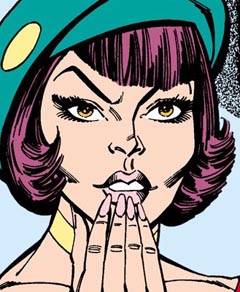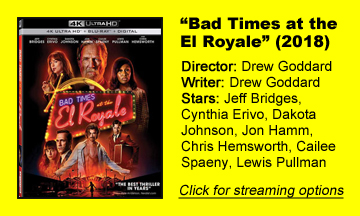Having proven himself in the Joss Whedon school (“Buffy,” “Angel”) and with crowd-pleasers (“The Martian”), writer-director Drew Goddard tries his hand at a Quentin Tarantino-style epic in “Bad Times at the El Royale” (2018).
The Tarantino comparison doesn’t serve the film well, especially when “Once Upon a Time … in Hollywood” is on my mind. There’s a fine, subjective line between artistic and indulgent filmmaking, and “Bad Times” too often falls on the wrong side of that line to be worth repeated watchings.
Incredible cast
For one viewing, it held my attention for the full 2 hours and 21 minutes, even though I was often aware that the movie is too long. The incredible cast, playing guests at the titular hotel along the California-Nevada line in the 1970s, is the main reason.
It’s highlighted by Jeff Bridges as a kindly priest and Cynthia Erivo (“The Outsider”) as a slightly past-her-prime lounge singer, and Lewis Pullman also steps in with a sympathetic turn as the lone hotelier.
Further spice comes from Dakota Johnson, Jon Hamm, “Thor’s” Chris Hemsworth and young Cailee Spaeny – who totally looks like Johnson’s kid sister, which is good because that’s who she plays. These characters come to the El Royale for their own reasons – ranging from a hidden treasure to FBI intrigue.
The El Royale is also a main character, but Goddard is overly enamored with it, showing off the wonderful 1960s-70s décor of a hotel a decade beyond its prime.
The bi-state nature of the property (where the California rooms cost a dollar more) doesn’t play a role except to set the stage for oddities such as two-way mirrors, hidden corridors, cameras and bugs. But actually, the most evocative thing about the hotel is Pullman’s monologue about the disturbing things he’s seen there through the years.
Broken into segments
I like how “El Royale” is broken into segments, labeled by room number, telling us the backstory of the person staying in each room. But I’m irked that the backstories are often better than what we’re currently spending time on.
For example, Hemsworth’s fascinating hippy sex cult gets much less screentime than Erivo singing in her room, practicing for her next gig.
Goddard aims for that Tarantino trick of building up our expectations that something is going to happen. Often, nothing happens in a given scene, which isn’t a problem on the first viewing, but I fear there’s not enough original artistry here for a second viewing.
Still, “El Royale” is by no means an empty text. Goddard has things to say about how everyone has their internal struggles and goals, and how lack of communication among strangers can lead to disaster. Mistrust between various pairings of characters starts this narrative’s downward spiral for everyone.
The morality of killing
I also like the Vietnam War commentary snuck into the background via a creepy news clip where Nixon argues that “ceasefire” doesn’t apply to this type of war.

“El Royale” ultimately makes a sharp observation about how society can intellectually separate murder from war killings, but it might feel the same, morally, to the person doing the killing. And that person – not the president or government that starts the war — bears the weight.
“El Royale” has a vibe of being amusing and twisty, but a vague sense of fun can’t quite overcome the feeling that every person is behaving badly (even if they might not all be bad people). A happyish ending gives us two people who started off on the right foot ending up on the right foot.
But, even though its lessons about communication and secrecy are well-taken, “Bad Times at the El Royale” nonetheless left me with too much of a bad, empty feeling given the time commitment.


